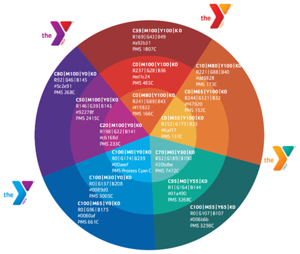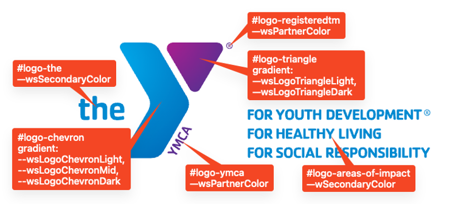Colorways
CSS Variables
Base Variables
We start by defining a base set of colors based on the “Y Color Wheel and Neighbored Color Zones” from the “Websites & Platforms Style Guide”, available in the YMCA Brand Resource Center. These colors are used to create the color palettes available in the Layout Builder.
Note: RGB variable values are not complete color definitions and must be wrapped in
rgb{a}(), likebackground-color: rgb(var(--ylb-color-rgb-red-dark), 0.5);. This allows you to control the opacity of the color.
:root {
--ylb-color-red-dark: #a92b31;
--ylb-color-rgb-red-dark: 169, 43, 49;
--ylb-color-red: #ed1c24;
--ylb-color-rgb-red: 237, 28, 36;
--ylb-color-red-light: #f15922;
--ylb-color-rgb-red-light: 241, 89, 34;
--ylb-color-orange-dark: #dd5828;
--ylb-color-rgb-orange-dark: 221, 88, 40;
--ylb-color-orange: #f47920;
--ylb-color-rgb-orange: 244, 121, 32;
--ylb-color-orange-light: #fcaf17;
--ylb-color-rgb-orange-light: 252, 175, 23;
--ylb-color-green-dark: #006b6b;
--ylb-color-rgb-green-dark: 0, 107, 107;
--ylb-color-green: #01a490;
--ylb-color-rgb-green: 1, 164, 144;
--ylb-color-green-light: #20bdbe;
--ylb-color-rgb-green-light: 32, 189, 190;
--ylb-color-blue-dark: #0060af;
--ylb-color-rgb-blue-dark: 0, 96, 175;
--ylb-color-blue: #0089d0;
--ylb-color-rgb-blue: 0, 137, 208;
--ylb-color-blue-light: #00aeef;
--ylb-color-rgb-blue-light: 0, 174, 239;
--ylb-color-purple-dark: #5c2e91;
--ylb-color-rgb-purple-dark: 92, 46, 145;
--ylb-color-purple: #92278f;
--ylb-color-rgb-purple: 146, 39, 143;
--ylb-color-purple-light: #c6168d;
--ylb-color-rgb-purple-light: 198, 22, 141;
--ylb-color-white: #FFFFFF;
--ylb-color-rgb-white: 255, 255, 255;
--ylb-color-light-grey-1: #f2f2f2;
--ylb-color-rgb-light-grey-1: 242, 242, 242;
--ylb-color-light-grey-2: #e7e7e7;
--ylb-color-rgb-light-grey-2: 231, 231, 231;
--ylb-color-light-grey-3: #cccccc;
--ylb-color-rgb-light-grey-3: 204, 204, 204;
--ylb-color-grey-1: #636466;
--ylb-color-rgb-grey-1: 99, 100, 102;
--ylb-color-grey-2: #4F4F4F;
--ylb-color-rgb-grey-2: 79, 79, 79;
--ylb-color-grey-3: #3F4042;
--ylb-color-rgb-grey-3: 63, 64, 66;
--ylb-color-dark-grey-1: #2F2F2F;
--ylb-color-rgb-dark-grey-1: 47, 47, 47;
--ylb-color-dark-grey-2: #231F20;
--ylb-color-rgb-dark-grey-2: 35, 31, 32;
--ylb-color-black: #000000;
--ylb-color-rgb-black: 0, 0, 0;
}
Colorway Variables
Each colorway is built upon four core colors derived from the base color palette:
PrimaryColor: The main color for the colorway.SecondaryColor: A complementary color to the primary.TertiaryColor: Another complementary color, providing additional visual interest.PartnerColor: A contrasting color, often used for buttons and calls to action.
These four colors are used to style the majority of page elements. Each variable is prefixed with ws to denote “Website Services”. RGB versions of these colors are also provided for use with rgba() styles.
In addition to the main colors, five more variables are used to define the YMCA logo gradients:
LogoChevronDarkLogoChevronMidLogoChevronLightLogoTriangleDarkLogoTriangleLight
Important: These
Logovariables should only be used for styling the YMCA logo. They are not intended for use in other page components. The Canadian Y logo does not change colors, and therefore these extra colors are not needed for Canadian colorways.
Here’s a complete list of the colorway variables:
--wsPrimaryColor
--wsPrimaryColorRGB
--wsSecondaryColor
--wsSecondaryColorRGB
--wsTertiaryColor
--wsTertiaryColorRGB
--wsPartnerColor
--wsPartnerColorRGB
--wsLogoChevronDark
--wsLogoChevronMid
--wsLogoChevronLight
--wsLogoTriangleDark
--wsLogoTriangleLight
These variables are typically defined by referencing the base color variables. Here’s an example of a complete colorway definition:
:root {
--wsPrimaryColor: var(--ylb-color-blue-dark);
--wsPrimaryColorRGB: var(--ylb-color-rgb-blue-dark);
--wsSecondaryColor: var(--ylb-color-blue);
--wsSecondaryColorRGB: var(--ylb-color-rgb-blue);
--wsTertiaryColor: var(--ylb-color-blue-light);
--wsTertiaryColorRGB: var(--ylb-color-rgb-blue-light);
--wsPartnerColor: var(--ylb-color-purple-dark);
--wsPartnerColorRGB: var(--ylb-color-rgb-purple-dark);
--wsLogoChevronDark: var(--ylb-color-blue-dark);
--wsLogoChevronMid: var(--ylb-color-blue);
--wsLogoChevronLight: var(--ylb-color-blue-light);
--wsLogoTriangleDark: var(--ylb-color-purple-dark);
--wsLogoTriangleLight: var(--ylb-color-purple-light);
}
Logo Colors
To ensure consistency and minimize code duplication, the YMCA logo is divided into six distinct sections, each styled individually:
thechevronymcatriangleregisteredtmareas-of-impact
The chevron and triangle sections use radialGradient elements, taking advantage of the wsLogo variables mentioned above. The other sections are styled using the standard colorway variables. Each section is a path element with a unique id and a color defined using the fill property.
#logo-theuses--wsSecondaryColor#logo-chevronuses a gradient composed of (from top to bottom)--wsLogoChevronLight,--wsLogoChevronMid, and--wsLogoChevronDark#logo-ymcauses--wsPartnerColor#logo-triangleuses a gradient composed of (from left to right)--wsLogoTriangleLightand--wsLogoTriangleDark#logo-registeredtmuses--wsPartnerColor#logo-areas-of-interestuses--wsSecondaryColor
Y Styles
Each “Y Styles” option activates a specific CSS library, as defined in
y_lb.ws_style_option.yml. These libraries can be overridden by a custom theme, allowing for further customization (see the
Drupal documentation on Overriding Theme Functions for details).

